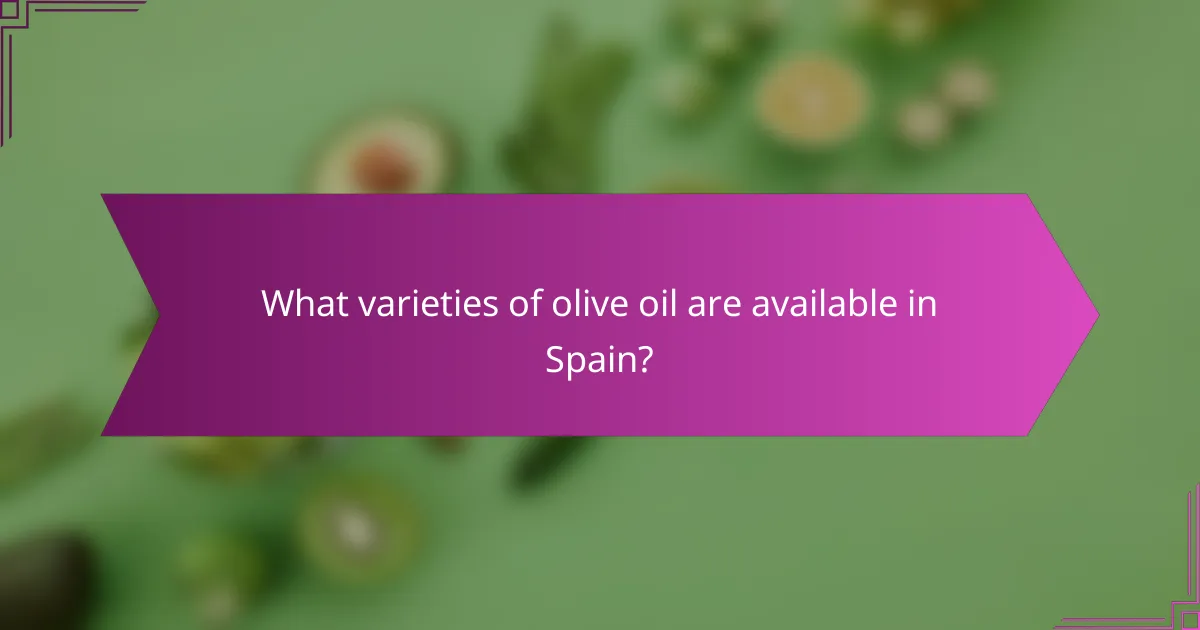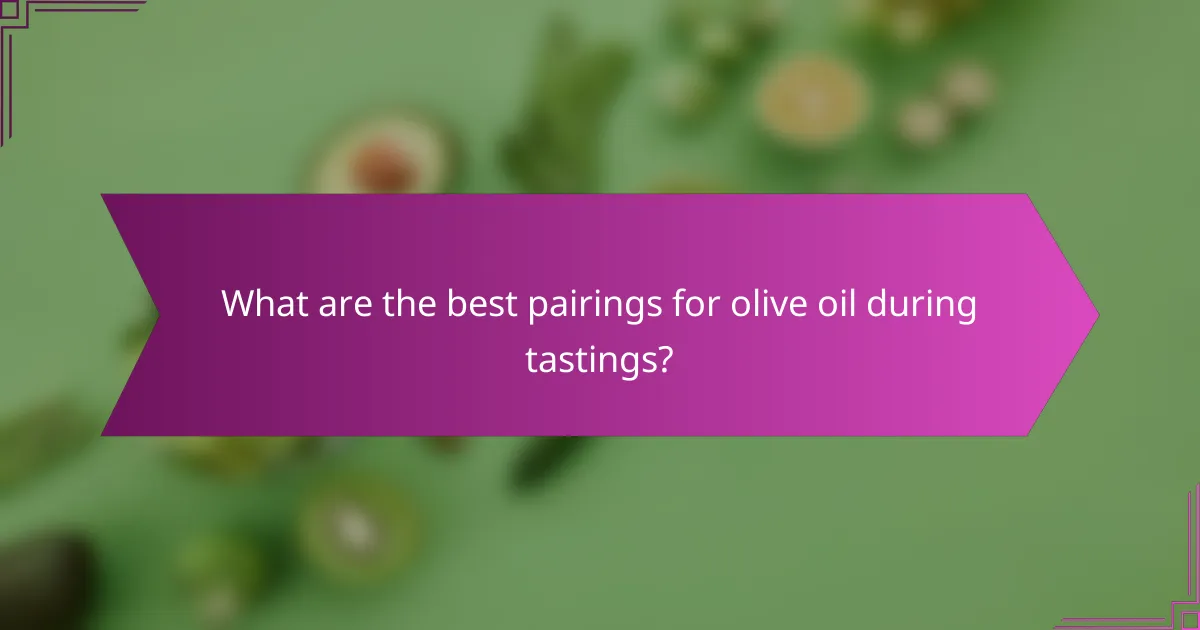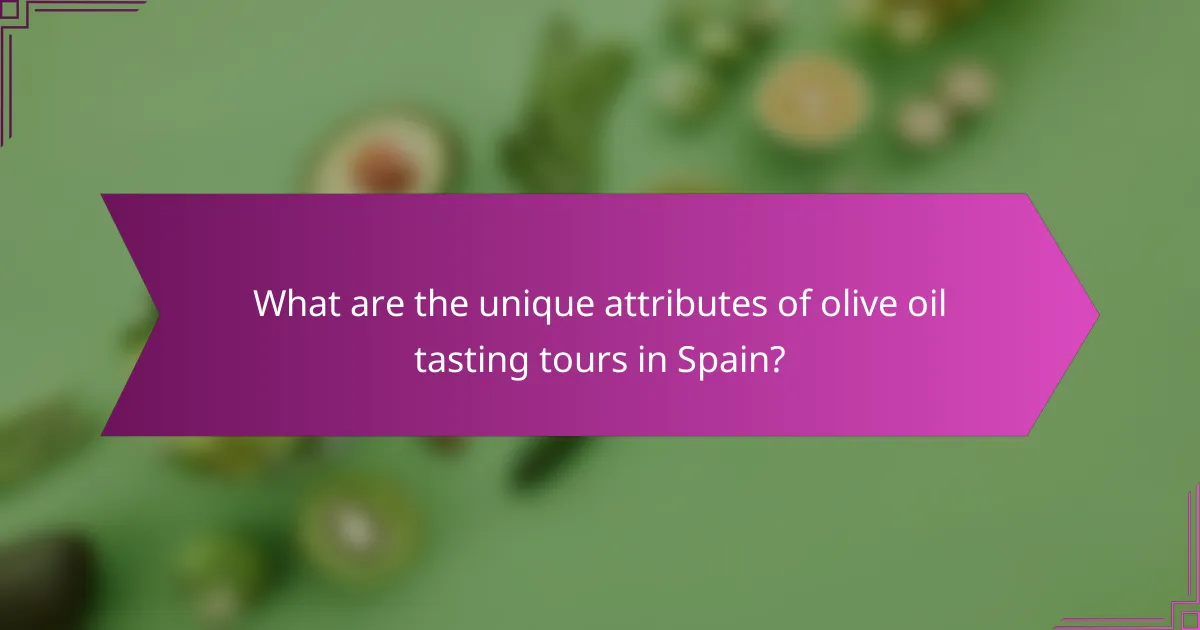Discover the health benefits of olive oil, including heart health and anti-inflammatory properties. Explore the diverse varieties found in Spain, such as extra virgin and Arbequina. Learn about ideal pairings that enhance tasting experiences, from bread to fresh vegetables. Experience immersive tours that connect you with local producers and traditional production methods.

What are the health benefits of olive oil?
Olive oil offers numerous health benefits, including heart health, anti-inflammatory properties, and antioxidant effects. It is rich in monounsaturated fats, which can lower bad cholesterol and reduce the risk of heart disease. Additionally, the polyphenols in olive oil contribute to its anti-inflammatory and antioxidant properties, promoting overall well-being. Incorporating various olive oil varieties, such as extra virgin, can enhance these benefits, especially when paired with healthy foods like vegetables and whole grains.
How does olive oil contribute to heart health?
Olive oil significantly contributes to heart health by reducing inflammation and lowering cholesterol levels. Rich in monounsaturated fats, it helps maintain healthy blood vessels and supports overall cardiovascular function. Studies indicate that regular consumption can decrease the risk of heart disease. The unique antioxidants in olive oil, such as oleocanthal, provide additional protective effects against heart-related issues.
What role does olive oil play in anti-inflammatory diets?
Olive oil is a key component in anti-inflammatory diets due to its high content of monounsaturated fats and antioxidants. These compounds, particularly oleocanthal, have been shown to reduce inflammation markers in the body. Regular consumption of olive oil can support heart health and lower the risk of chronic diseases linked to inflammation. Varieties such as extra virgin olive oil retain more beneficial compounds, enhancing their health benefits. Pairing olive oil with anti-inflammatory foods like leafy greens or fatty fish can further amplify its positive effects.
Which antioxidants are found in olive oil?
Olive oil contains several antioxidants, including oleocanthal, oleuropein, and hydroxytyrosol. These compounds contribute to its health benefits by reducing inflammation and oxidative stress. Oleocanthal exhibits anti-inflammatory properties similar to ibuprofen, while oleuropein is known for its cardiovascular benefits. Hydroxytyrosol is a potent antioxidant that helps protect cells from damage. These antioxidants enhance the overall quality and health benefits of olive oil, making it a valuable addition to a healthy diet.

What varieties of olive oil are available in Spain?
Spain offers several varieties of olive oil, including extra virgin, virgin, and refined olive oil. Extra virgin olive oil is the highest quality, known for its low acidity and rich flavor. Virgin olive oil has slightly higher acidity and is still suitable for consumption. Refined olive oil undergoes processing to neutralize strong flavors and acidity, making it more versatile for cooking. Unique varieties include Arbequina, Picual, and Hojiblanca, each with distinct taste profiles and culinary uses.
How do different olive cultivars affect flavor profiles?
Different olive cultivars significantly impact flavor profiles, creating distinct tasting experiences. Varieties such as Arbequina offer a mild, fruity flavor, while Picual presents a robust, peppery taste. The unique attributes of each cultivar influence aroma and mouthfeel, enhancing the overall tasting experience. Factors like climate and soil also contribute to these variations, making olive oil tasting tours in Spain a rich exploration of flavors.
What are the distinctions between extra virgin and virgin olive oil?
Extra virgin olive oil has lower acidity and superior flavor compared to virgin olive oil. Extra virgin oil is cold-pressed, ensuring higher quality and taste. Virgin olive oil undergoes a slightly less stringent process, resulting in a milder flavor and higher acidity. Both oils offer health benefits, but extra virgin is richer in antioxidants and healthy fats.
Which regional olive oils are most sought after?
The most sought-after regional olive oils in Spain include those from Andalusia, Catalonia, and the Balearic Islands. These regions are renowned for their unique flavors and high-quality production methods. Andalusian olive oils, such as those from the Sierra de Cazorla, are celebrated for their robust taste and health benefits. Catalonia offers a variety of oils with fruity and nutty profiles, while the Balearic Islands produce oils with distinct floral notes. Each region’s unique climate and soil contribute to the exceptional quality and diversity of their olive oils.

What are the best pairings for olive oil during tastings?
The best pairings for olive oil during tastings include bread, cheese, vegetables, fish, and fruits. These pairings enhance the oil’s flavor and showcase its unique attributes. For example, crusty bread allows for the appreciation of the oil’s aroma and taste. Fresh vegetables, such as tomatoes and peppers, complement the oil’s richness. Cheese varieties, particularly aged or creamy ones, create a balanced experience. Fish dishes, especially grilled or roasted, harmonize with the oil’s profile. Finally, fruits like citrus or apples provide a refreshing contrast.
How can olive oil enhance the flavor of different foods?
Olive oil enhances the flavor of different foods by adding richness and depth. Its fruity, peppery, or nutty notes complement various cuisines. For example, drizzling high-quality extra virgin olive oil over salads brightens the taste. Pairing olive oil with grilled vegetables intensifies their natural sweetness. Additionally, using olive oil in marinades infuses proteins with flavor and moisture. The versatility of olive oil allows it to elevate both simple and complex dishes, making it a staple in culinary practices.
Which dishes benefit the most from olive oil pairings?
Dishes that benefit the most from olive oil pairings include salads, grilled vegetables, seafood, pasta, and bread. These pairings enhance flavors and add health benefits. For instance, drizzling high-quality olive oil on fresh salads boosts nutrient absorption. Grilled vegetables gain depth from olive oil’s richness, while seafood is complemented by its lightness. Pasta dishes often use olive oil as a base for sauces, enhancing taste and texture. Finally, bread dipped in olive oil is a classic pairing that highlights the oil’s unique attributes.

What should you expect on an olive oil tasting tour in Spain?
On an olive oil tasting tour in Spain, expect to sample various high-quality olive oils, learn about production methods, and discover food pairings. Tours often include visits to olive groves and mills, offering insights into the health benefits of olive oil, such as its rich antioxidant content. You will experience different varieties, including extra virgin and flavored oils, each with unique tasting notes. Engaging with local producers enhances your understanding of regional differences and the cultural significance of olive oil in Spanish cuisine.
How are olive oil tastings structured?
Olive oil tastings are structured to enhance the sensory experience of participants. Typically, tastings begin with an introduction to the various olive oil varieties, focusing on their unique attributes. Participants then engage in a guided tasting, where they sample different oils, noting flavors, aromas, and textures.
The process often includes visual assessment, smelling, and tasting in specific order. This allows participants to appreciate the health benefits and culinary pairings of each oil. As a result, tastings foster a deeper understanding of olive oil’s qualities, particularly those from Spain, known for their diverse varieties and rich flavors.
What are common misconceptions about olive oil tastings?
Common misconceptions about olive oil tastings include the belief that all olive oils taste the same and that higher price guarantees better quality. Many think that olive oil should be stored in the refrigerator, which can alter its flavor. Additionally, some people assume that tasting olive oil is similar to tasting wine, but the techniques differ significantly. Understanding these misconceptions can enhance the experience of olive oil tasting tours in Spain, where diverse varieties and health benefits are showcased.

How can you choose the right olive oil for your palate?
To choose the right olive oil for your palate, consider its flavor profile, aroma, and acidity level. Start with a tasting tour to sample different varieties. Look for oils labeled as extra virgin for the highest quality. Pay attention to the region of origin, as Spanish olive oils often have distinct characteristics. Experiment with pairings, such as drizzling on salads or dipping with bread, to discover your preferences.
What tasting techniques can enhance your experience?
To enhance your olive oil tasting experience, focus on visual, olfactory, and gustatory techniques. First, observe the color and clarity of the oil. Next, swirl the oil gently in the glass to release its aroma, then take a deep inhale to identify the various scents. Finally, take a small sip, allowing the oil to coat your palate, and note the flavors and textures. This multi-sensory approach enriches the tasting experience, revealing the unique attributes of different olive oil varieties.
Which characteristics should you look for in high-quality olive oil?
Look for extra virgin classification, low acidity, rich flavor, and aroma in high-quality olive oil. These characteristics indicate superior quality and health benefits. Extra virgin olive oil must have an acidity level below 0.8%. A robust flavor profile often includes notes of fruitiness, bitterness, and spiciness. The aroma should be fresh and vibrant, enhancing the tasting experience.

What are the unique attributes of olive oil tasting tours in Spain?
Unique attributes of olive oil tasting tours in Spain include regional diversity, expert guidance, immersive experiences, local cuisine pairings, and educational components. Each tour often highlights unique olive varieties, such as Picual and Arbequina, which provide distinct flavor profiles. Additionally, many tours offer insights into traditional production methods, enhancing the tasting experience. Visitors may also engage in sensory evaluations, learning to identify subtle differences in aroma and taste.
How do cultural factors influence olive oil tasting experiences?
Cultural factors significantly shape olive oil tasting experiences by influencing preferences, perceptions, and pairings. Regional traditions dictate the types of olive oils favored, such as fruity or robust varieties. Culinary customs also affect how olive oil is paired with foods, enhancing flavors and overall enjoyment. Additionally, cultural backgrounds impact the appreciation of tasting notes, with local knowledge enriching the tasting experience. Overall, these elements create a unique context for each tasting, reflecting the diverse heritage of olive oil production in Spain.
What unique local practices enhance olive oil production in Spain?
Unique local practices that enhance olive oil production in Spain include traditional harvesting methods, specific regional processing techniques, and unique soil conditions. These practices ensure high-quality oil with distinct flavors. For example, hand-picking olives preserves their integrity and contributes to better taste profiles. Additionally, the use of stone mills in some areas maintains the oil’s natural characteristics. The diverse microclimates across Spain create unique terroirs, influencing the flavor and quality of the olive oil produced.
Which rare olive oil varieties should you seek out?
Seek rare olive oil varieties like Picual, Arbequina, and Cornicabra. These oils offer unique flavors and health benefits.
1. Picual: High oleic acid content enhances heart health.
2. Arbequina: Known for its fruity and nutty taste, rich in antioxidants.
3. Cornicabra: Distinctive peppery flavor, beneficial for digestion.
4. Hojiblanca: Balanced flavor profile, excellent for pairing with cheese.
5. Frantoio: Robust and grassy notes, ideal for drizzling over dishes.
6. Leccino: Mild and sweet, complements various cuisines.
What are the best practices for enjoying olive oil tastings?
To enjoy olive oil tastings, focus on the quality of the oil and the right pairings. Start with a clean palate, using bread or vegetables to cleanse between tastings. Savor the aroma first, then take small sips to appreciate the flavor profiles. Explore various varieties, such as extra virgin and flavored oils, to experience unique attributes. Pair olive oil with complementary foods like cheeses or fruits to enhance the tasting experience.



